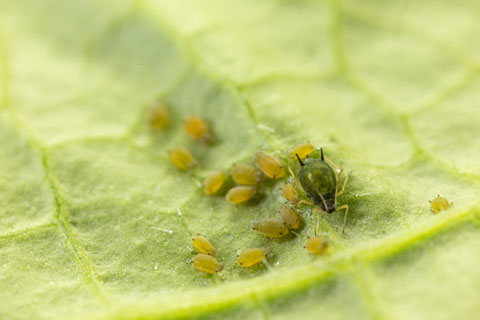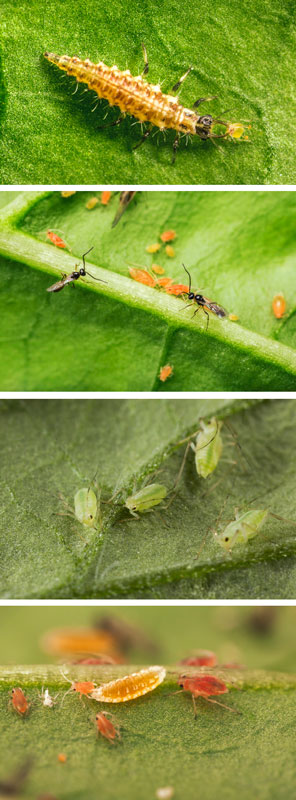3/1/2025
Aphids: It’s Go Time
Jeremy Webber

Pictured: The darker-colored cornicles visible here are a dead giveaway for identification with Aphis gossypii.
“Know thy enemy and know yourself; in a hundred battles, you will never be defeated.” This famous quote from “The Art of War” by Sun Tzu has worked well for military strategists for centuries and it very much applies to our perennial battles with aphids as well. When we discuss biocontrol options for aphids, it’s very easy to get lost in the weeds with this massive group of pest insect. If you’re going the pesticide-free or reduced pesticide route with your battle plan, understanding a few key points about the main ones that you’re likely to find will go a long way towards winning the war this spring.
Aphis gossypii, aka melon or cotton aphid
This species is ubiquitous in horticulture globally, as they have a host range of over 700 plant species. That said, they prefer warmer environments and can still develop quickly in early summer when some of our other problematic species are beginning to slow down. Each female can produce three to 10 living aphid nymphs per day, with the optimal temperature for rapid development falling somewhere around 82F (27C). In cucumbers, where they’re arguably at their happiest, they can multiply their population 12 times in a week! There are always exceptions to the rule, but these are usually found on the undersides of the leaves and show up in a range of colors. The main thing that helps with a quick ID in the field are their dark cornicles (“tail pipes”). This is a consistent feature no matter what color you find them in.
From a biocontrol standpoint, Aphidius colemani is your primary parasitic wasp of choice. There’s still some parasitism capable from A. matricariae, but A. colemani is the best option and it’s typically the lowest-priced option out there as well. That said, it takes a while to get the numbers in a crop to rapidly knock this species down, so you’ll need to scout your plants well if you’re relying on this BCA for the bulk of your control. If you’re using banker plants, this and Myzus are the main species that you’re going to be affecting. Alternatively, the gall midge Aphidoletes aphidimyza is a fantastic control option, as well as bulk releases of Chrysoperla eggs and/or larvae.

Pictured: 1. Someone’s having a bad day! Green lace wing larvae are terrifying if you’re lucky enough to witness them in action.
2. The parasitic wasp Aphidius colemani inspecting a colony of Myzus preparing to lay their eggs inside of the pests.
3. These green-colored potato aphids are clearly showing the darker dorsal stripe that makes ID relatively easy.
4. Larvae of the Aphidoletes gall-midge feeding on an aphid. It’s a horror movie for the pest and it’s almost enough to make me feel bad for them on occasion when I’m lucky enough to see this in a crop ... almost.
Myzus persicae, aka the green peach or tobacco aphid
Likely the most problematic species that we deal with in ornamental horticulture, there are two primary subspecies here that tend to complicate the discussion. One is subspecies M. persicae, the peach potato aphid, aka green peach aphid, and the other is M. persicae subspecies nicotianae, the tobacco aphid. Both subspecies have numerous choices in terms of crops and are highly problematic for virus transmission. The tobacco aphid is known to be capable of transmitting at least 100 different viruses! They’re both a bit more active in cooler temps than cotton aphid, with ideal temps falling in the upper 60s. At 68F (20C), they’re doubling their population size every 2.7 days. The green peach aphid can present in darned near any color it feels like, from light green/yellowish all the way into the red spectrum. The tobacco aphid always presents in pink or red. They can live wherever they feel like in the crop, but both types prefer younger growth, and it’s common to see them in tight colonies clustered up near the growing tips or flowers in the crop.
The fun part about this aphid, at least from a biocontrol standpoint, is that we don’t really need to know which of the subspecies we’re working with. It’s a fun hobby, I suppose, but at the end of the day, growers typically just want them gone and identifying the problem down to the genus/species level is sufficient to make that happen.
Koppert’s recommendations are for “Myzus” in general and this is as specific as we’ve found that we need to be. Parasitic wasps can work well from a preventative level on this species, but thorough scouting is mission critical if you’re seriously planning on relying on them. One-hundred percent parasitism on a colony with 500 aphids is still a plant you likely aren’t shipping. If wasps are going to do the job for you, you want them on that colony when there’s just a few, not a few hundred. Aphidius colemani (the one you can grow on bankers) works well enough, assuming there are enough in the greenhouse, and that they’re distributed well and often; however, Aphidius matricariae is more active in cool climates than A. colemani and we generally find better/more consistent results when they’re in the mix, especially early in the season.
That said, wasp-based systems have a lot of moving parts and results with predators are always a bit more straightforward. Assuming you can get Chrysoperla eggs and/or larvae on target every week, it’s really just a numbers discussion from that point. It’s easy to see how and why we compare green lacewing egg apps every week to applying a contact insecticide. It’s literally the same concept, just with a different “mode of action.” The best part? No mummies, no evidence. Just dried up aphid husks and chunky little alligators running around in the canopy (that you’ll likely never see anyway).
Aphidoletes are another big possibility here, as well. Assuming you can get the correct numbers into the canopy each evening they’re a solid option, with less evidence than the traditional wasp approach. They get lumped into the wasp category, but really, they’re predators with a built-in and automated airborne delivery mechanism.
Macrosiphum euphorbiae, aka the potato aphid
These show up occasionally, but I find them worth noting as A. colemani and A. matricariae have near zero efficacy. Generally speaking, the adults are huge! It’s not uncommon for full-grown adults to be two times the size of a full-grown cotton aphid (nearly 4-mm long). While they prefer solanaceous plants, they have a host range of over 20 families. They can be found on stems, flower buds in roses, underneath leaves—nearly anywhere in a crop. I’ve found them misidentified as Myzus on a number of occasions, as the one or two adults in the colony aren’t seen while scouting and the smaller nymphs look like adult green peach to the untrained eye. The main thing to look for with this species is a darker colored stripe that runs down its back. Regardless of presentation in light green or pink, it will still have this darker dorsal stripe that easily stands out with a basic 10x hand lens.
Aphidius ervi gets the nod here as the wasp of choice for this pest. When they’re a known entity, it’s usually helpful to at least have a few in the system each week to support. They’re considerably more aggressive and just larger than A. colemani and A. matricariae and are quite capable of managing this pest on their own if they’re introduced aggressively enough. Back to the recurring theme from the previous two aphid species, predators work, too, and they don’t care nearly as much which species it is. The same program with Chrysoperla and/or Aphidoletes recommended for peach and cotton aphid works here, too.
Marching orders
There are many more aphid species to deal with and other biocontrols, as well. This just scratches the surface with a touch on the major players. Make sure you’re partnered up with a trusted advisor and supplier of BCAs for the best results. There are numerous options available and it helps immensely to have someone you trust working with you that can help to manage all of the variables. GT
Jeremy Webber is the National Ornamental Consultant Team Manager for Koppert U.S. He can be reached at jwebber@koppert.com.